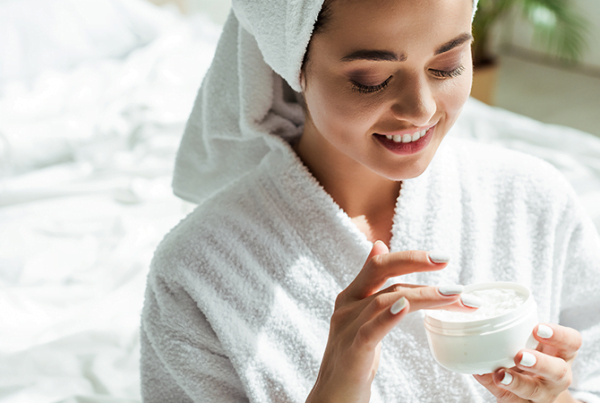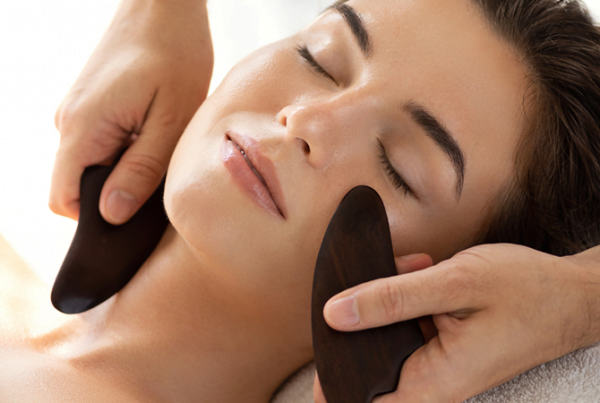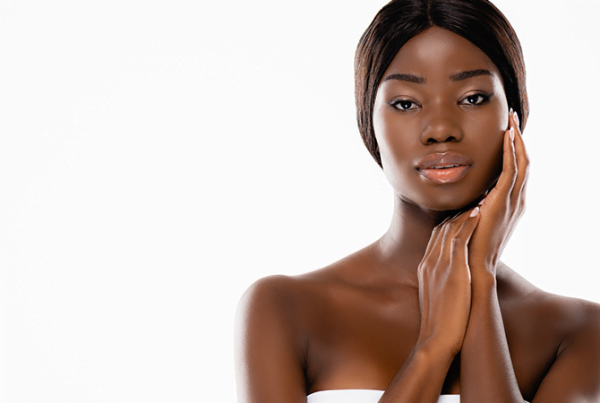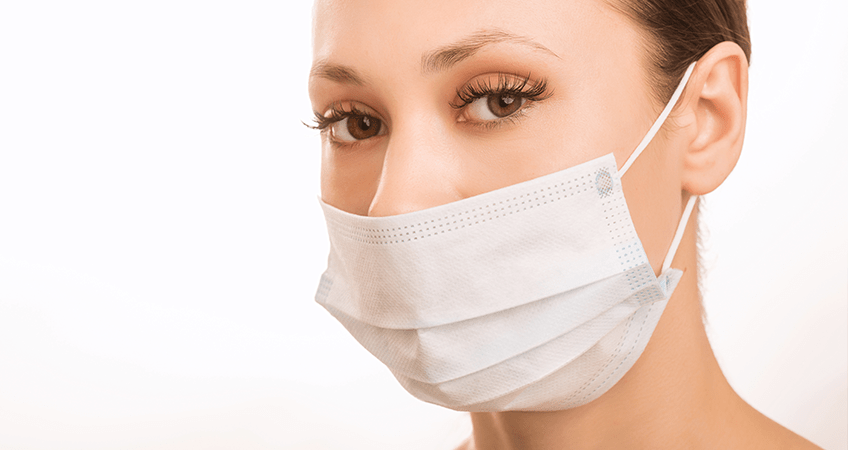
Reducing the spread of COVID-19 is so important, and wearing a mask is one of the best ways to do that. Choosing to wear a mask in public now helps you protect others and slow the spread of the virus. But wearing a mask has some unfortunate side effects most of us weren’t anticipating: acne breakouts. Acne breakouts from wearing a mask are now being called maskne.
Maskne can happen even when you only wear your mask for a little while. That means that even quick errands while wearing a mask can impact your skin. In this blog post, we’ll dive into what happens to lead to maskne and how to cure and prevent it from wreaking havoc on your skin.
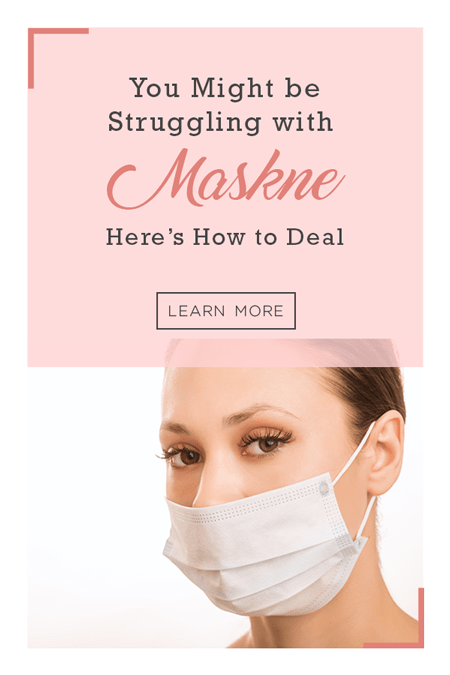
What Is Maskne?
Maskne, which is also called mascne or acne mechanica, happens when breakouts pop up on the bottom half of your face typically covered by a face mask. Two main things cause maskne. First, friction between the mask and your skin causes acne breakouts. Friction between your skin and the mask irritates the surface of your skin and breaks down your skin barrier, which makes it a lot easier for pollutants to clog your pores. This happens when the humidity and moisture that builds up under your mask when you wear it for a longer time period.
Wearing a mask is so important to protect yourself and others, but understanding why it can cause acne is also important to keep your skin healthy.
Moisture
When your skin is trapped underneath a face mask, your breath creates a more humid environment. The longer you wear your mask, the more humidity builds up between the mask and your skin. That humidity creates an environment that’s basically an acne breeding ground.
Bacteria
Bacteria is one of the biggest causes of acne. When sweat, oil, and makeup become trapped under your mask, they clog your pores. This builds up the bacteria present in your pores and leads to acne. Then, when you remove your mask and touch your skin, oil, dirt, and bacteria from your hands end up clogging your pores even more. All of this leads to acne breakouts.
Friction
When your mask moves around on your face, it creates friction, which can damage your skin’s protective layer called the skin barrier. Without that protective layer, bacteria and grime settle into your pores and create acne breakouts much easier.
How To Cure and Prevent Maskne
Keeping your skin happy and healthy requires following a simple, effective skincare routine. You need to take care of your skin all of the time, but especially now when you have so much going on that could create acne. Cleansing and moisturizing are the most important parts of your skincare routine. When you’re hoping to treat maskne, remember to be gentle in eliminating the bacteria and oil buildup while protecting and restoring your skin’s barrier. Here are some specific tips for curing and preventing maskne.
Carefully Choose Your Face Mask
When you choose a face mask, make sure to pick one made from a lightweight, breathable material like cotton, silk, or satin. Those materials are less likely to trap the heat and humidity or irritate your skin by breaking down that protective barrier. Beyond that, wash your mask regularly to keep the germs at bay.
Use A Gentle Cleanser
Gentle cleansers are the best option for keeping your skin healthy. Regularly wash your face to remove dirt, sweat, and dead skin cells. Avoid aggressive or harsh products and focus on gently cleansing the skin instead. You never want to strip or damage your skin. Thankfully, we have the perfect cleanser to help you replenish your skin!
Use a Spot Treatment
Spot treatments help take care of the acne on your face by healing pimples. Usually, traditional spot treatments like benzoyl peroxide and salicylic acid are super effective at treating pimples. But for maskne, you have to be extra aware of how your skin could be affected. You shouldn’t apply harsh treatments in spots where you’re going to be wearing your mask again. If the mask rubs against the spot treatment, it intensifies its effects, which makes the irritation and inflammation happening on your skin worse. Instead, we highly recommend our HD Spark Acne Spot Treatment! It helps reduce swelling and redness in your acne spots and promotes the healing process.
When you use spot treatments for maskne, make sure to only use them at night. If you want to treat your maskne during the day, consider trying out a hydrocolloid pimple patch. These patches help remove the toxins and buildup from your pores that led to that specific pimple. They also, if you’re going to wear them during the day, provide another layer to act as a barrier between the mask and your skin to help alleviate that irritating rubbing.
Change Your Mask
Remember to switch up your mask. To keep that humidity and moisture build-up to a minimum, change out the mask you’re wearing frequently. If you’re struggling with maskne impacting your skin, focus on washing your masks, switching them out regularly, and purchasing masks that will help your skin. Like we mentioned above, look for lightweight fabric masks like cotton, silk, or sating that won’t create friction and irritate your skin.
Don’t forget to wash a new mask before wearing it for the first time. Then, wash your mask (or masks) frequently to remove dirt and bacteria. The best tip to prevent maskne is to purchase a few masks and if you’re going to be wearing it for a long period of time, switch them out.
Avoid Oils
Try to avoid adding excess oil in your skincare products. These oil-based products can make you sweat more quickly, making things much worse for building up under your mask and clogging your pores to create acne. Instead, look for lightweight, oil-free moisturizers and mineral-based sunscreens (remember to still wear sunscreen when you’re wearing a mask!). Those sunscreens will help you avoid inflammation because they contain zinc, which is naturally anti-inflammatory. Our HD Ultra Replenishing Sunscreen SPF 40 is safe for acne-prone skin and won’t irritate or inflame your skin.
Use Retinol
Have you ever tried retinol before? It’s a go-to for fighting acne. It can sometimes irritate your skin, so to use retinol to treat acne, there’s a special way to protect and treat your skin at once. Use what’s called the sandwich method: layer on moisturizer, add retinol, and then add more moisturizer to dilute the retinol and protect your skin. This helps reduce redness or inflammation the retinol could cause. Make sure to choose a gentle, low concentration of retinol and start off by only using it every other night to see how it impacts your skin. Remember to only use retinol at night, since it can make your skin sensitive to the sun (and be sure to apply sunscreen during the day, even while wearing a mask). If you’re planning to use a combination of spot treatment and retinol, alternate the nights you use each.
Maskne is an unfortunate side effect of wearing a mask, but doing so is beyond important to protecting our communities and ourselves. That’s why we have to know how to prevent and treat these acne breakouts wherever possible. Remember to choose gentle products and make a conscious effort to protect your skin every single day, especially if you’re wearing a mask for long periods of time during the week.

